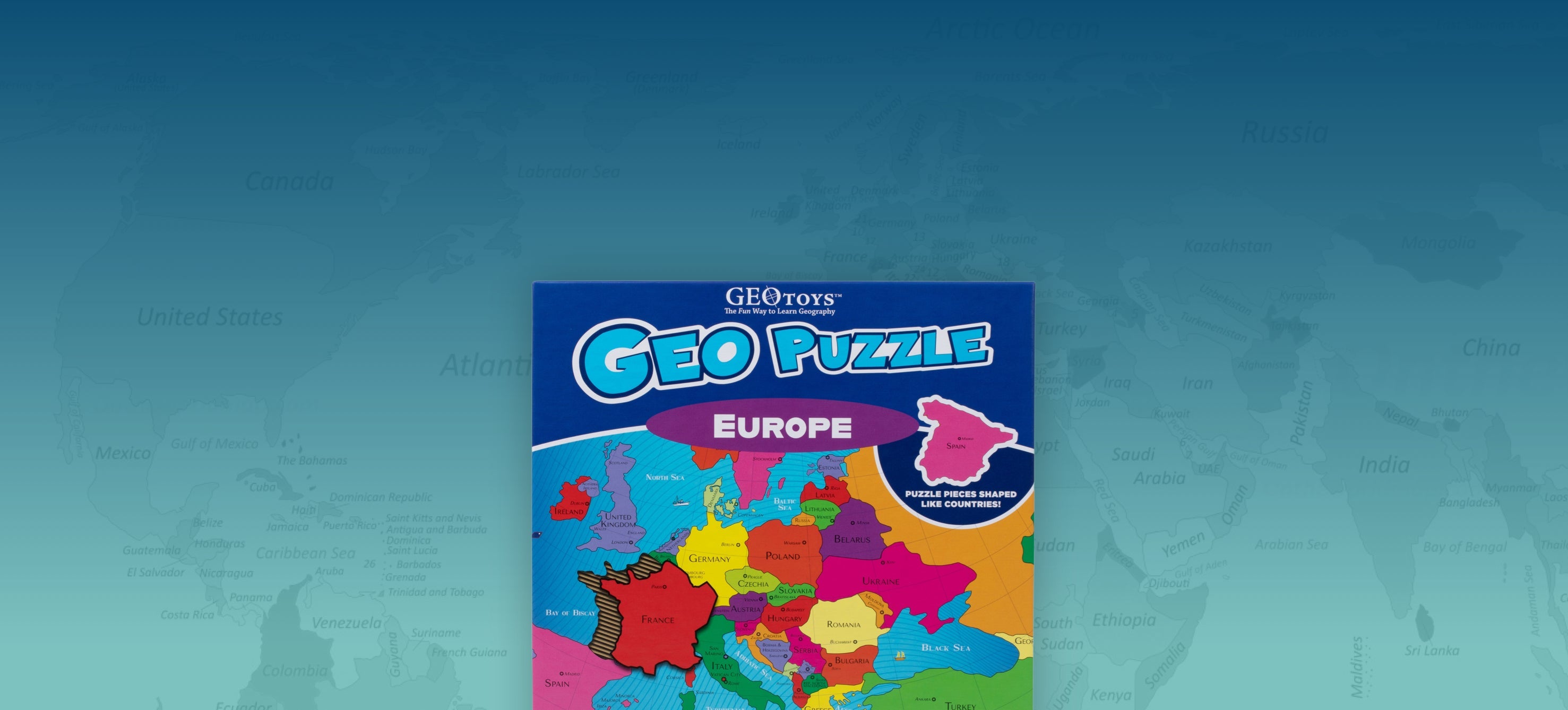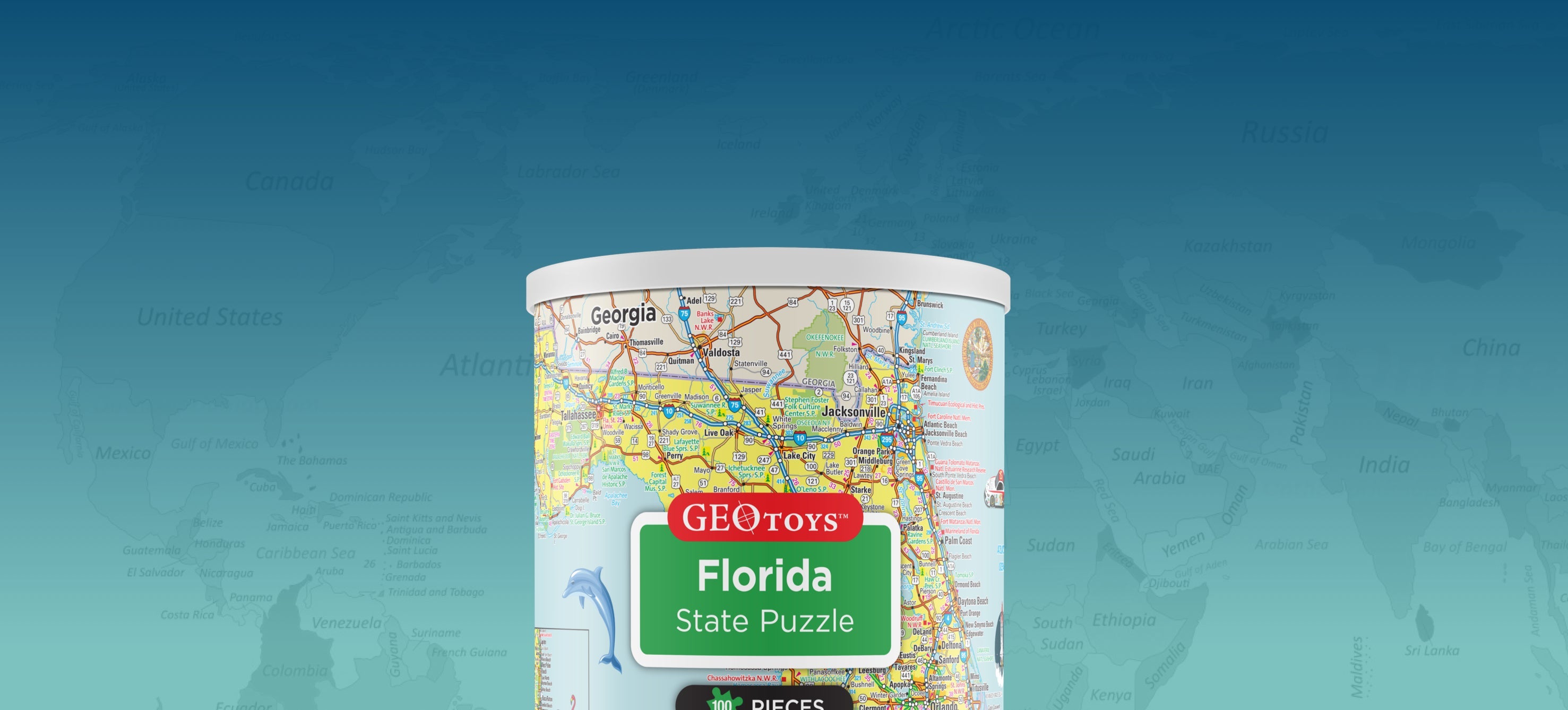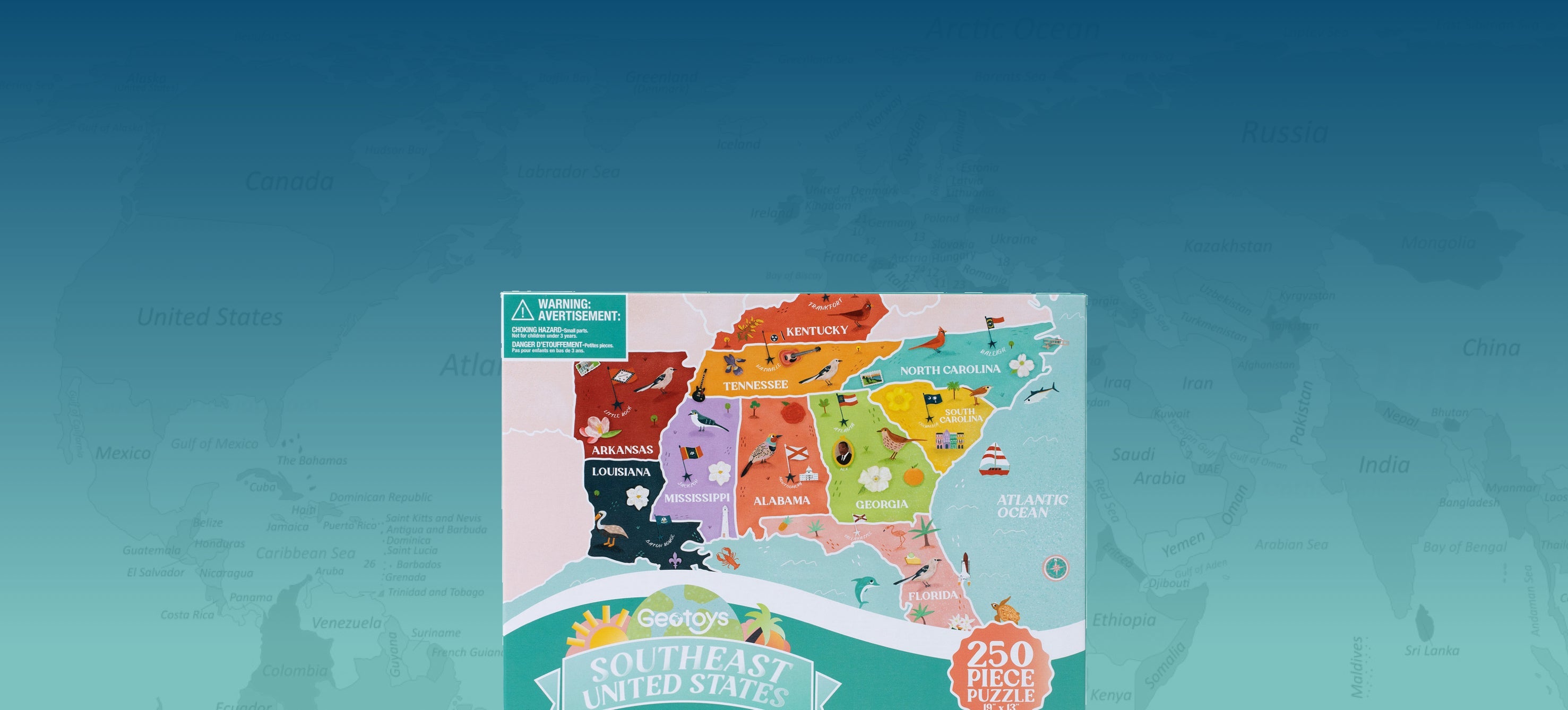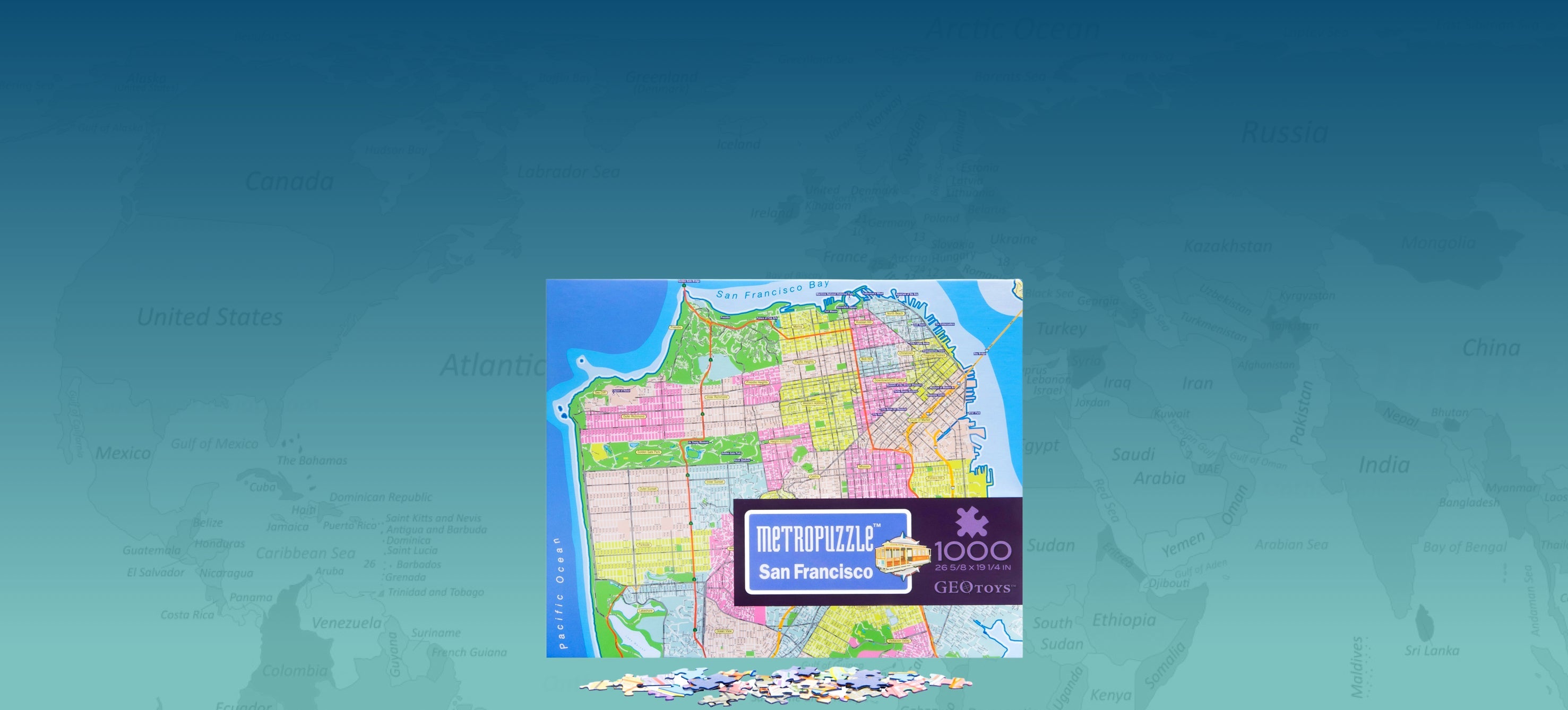Geo Facts Mid-Atlantic
Welcome to the Geotoys State Facts page for our Mid-Atlantic GeoPuzzle.
Here we’ll explore:
- State Capitals State birds and flowers (you’ll see them on your map)
- Animals and plants that live in the state
- National Parks Services locations within the state
- AND share information on “easter eggs” you may have spotted as you pieced your map together.
Let’s go!
Jump to New York * Jump to New Jersey * Jump to Pennsylvania * Jump to Delaware * Jump to West Virginia * Jump to Virginia * Jump to Maryland * Jump to Washington, D.C.New York

Capital: Albany
Albany, situated along the Hudson River, has serves as the state's capital since 1797. It remains one of the oldest continuously chartered cities in the United States, with a rich history dating back to its founding by Dutch settlers in 1614.
State Bird: Eastern Bluebird

The Eastern Bluebird (Sialia sialis) was designated as New York's state bird in 1970. Known for its vibrant blue plumage and melodic song, the Eastern Bluebird is commonly found in open woodlands and farmlands across the state.
State Flower: Rose

The rose (Rosa) was adopted as the state flower in 1955. This versatile flower thrives in various colors and varieties throughout New York.
Plants and Animals
The state's forests are dominated by species such as red and black spruce, balsam fir, white pine, and maple. Meadow flowers include dandelions, Queen Anne's lace, goldenrod, and black-eyed Susans. Wetland areas are abundant with cattails and rushes. Notably, all native orchids, five species of rhododendron (including azalea), and trillium are among the protected plant species in New York
The state is home to mammals such as white-tailed deer, black bears, beavers, and raccoons. Bird species include the Eastern Bluebird, American robin, and various raptors. Aquatic habitats support brook trout (the state fish) and striped bass. Wetlands and coastal areas provide habitats for amphibians, reptiles, and numerous invertebrates.
NPS Locations
- Statue of Liberty National Monument
- Ellis Island
- Saratoga National Historical Park
- Fire Island National Seashore
- Women's Rights National Historical Park
- African Burial Ground National Monument
Easter egg:

The National Baseball Hall of Fame and Museum in Cooperstown, New York, celebrates the history and heritage of America's favorite pastime. Founded in 1939, it honors legendary players, managers, and contributors who have shaped the game, showcasing iconic artifacts, memorabilia, and interactive exhibits. Located in the scenic village of Cooperstown, the Hall of Fame draws baseball fans from around the world to explore the sport's enduring legacy.
Jump to New York * Jump to New Jersey * Jump to Pennsylvania * Jump to Delaware * Jump to West Virginia * Jump to Virginia * Jump to Maryland * Jump to Washington, D.C.
New Jersey

Capital: Trenton
Trenton is the capital city of New Jersey. It was established as the capital in 1790.
State Bird: Eastern Goldfinch

The Eastern Goldfinch (Spinus tristis), also known as the American Goldfinch, is New Jersey's state bird. Designated in 1935, this small songbird is recognized for its vibrant yellow plumage in males during the breeding season and its cheerful, melodic song. Eastern Goldfinches are commonly found across the state in open fields, meadows, and suburban areas, where they feed primarily on seeds.
State Flower: Common Meadow Violet

The Common Meadow Violet (Viola sororia) is the state flower of New Jersey, adopted in 1971. This native wildflower features heart-shaped leaves and striking purple-blue petals. It thrives in moist, shaded environments such as woodlands and meadows and blooms in early spring, adding a splash of color to the landscape.
Plants and Animals
New Jersey's diverse ecosystems include deciduous forests dominated by oaks, maples, hickories, and birches. The northern regions feature species like sugar maple and eastern hemlock, while southern areas are known for the unique Pine Barrens ecosystem with pitch pine and Atlantic white cedar. The state has extensive wetlands supporting cattails, reeds, and salt marsh grasses. Coastal dunes are home to beach grasses and maritime shrubs like bayberry and beach plum. Native wildflowers such as black-eyed Susans, wild bergamot, and goldenrod are common. The state is also known for its cranberry bogs and blueberry farms, particularly in the Pine Barrens.
Wildlife includes white-tailed deer, black bears, red foxes, raccoons, and eastern cottontail rabbits. Smaller mammals like squirrels, chipmunks, and opossums are widespread. New Jersey's location along the Atlantic Flyway makes it a prime spot for birdwatching. Species include bald eagles, ospreys, great blue herons, and a variety of migratory songbirds. New Jersey is home to the northern diamondback terrapin, eastern box turtle, and various species of frogs and salamanders. The Pine Barrens support unique species like the Pine Barrens treefrog.
NPS Locations
- Delaware Water Gap National Recreation Area (portion in New Jersey)
- Morristown National Historical Park
- Thomas Edison National Historical Park
- Gateway National Recreation Area (Sandy Hook Unit)
- Appalachian National Scenic Trail (portion in New Jersey)
- New Jersey Pinelands National Reserve
- Great Egg Harbor River
- Lower Delaware National Wild and Scenic River (portion in New Jersey)
- Crossroads of the American Revolution National Heritage Area
Easter egg:

The Statue of Liberty, a gift from France in 1886, stands as a universal symbol of freedom and democracy in New York Harbor. While it is often associated with New York, the statue is located on Liberty Island, which, despite being in the territorial waters of New Jersey, is federally administered as part of New York. This geographical nuance has led to ongoing debates, as nearby Ellis Island, historically shared between the two states, reinforces the statue's proximity to New Jersey.
Pennsylvania

Capital: Harrisburg
Harrisburg has served as Pennsylvania's capital since 1812.
State Bird: The Ruffed Grouse

The Ruffed Grouse (Bonasa umbellus) was designated as the state bird in 1931. This medium-sized game bird is known for its distinctive drumming sounds produced by males during the mating season. Ruffed Grouse inhabit Pennsylvania's deciduous and mixed forests, where they feed on buds, leaves, and insects.
State Flower: Mountain Laurel

The Mountain Laurel (Kalmia latifolia) became the state flower on May 5, 1933. This evergreen shrub features beautiful star-shaped blossoms, typically pink or white, and thrives in the state's woodlands and mountainous areas.
Plants and Animals
The state's forests are dominated by species such as oak, maple, hickory, and the state tree, the Eastern Hemlock (Tsuga canadensis). The understory is rich with shrubs like rhododendron and azalea, while wildflowers such as trillium, black-eyed Susan, and Pennsylvania's state beautification and conservation plant, the Penngift Crownvetch, add seasonal color.
Mammals include white-tailed deer, black bears, and eastern gray squirrels. Bird species range from the Ruffed Grouse to bald eagles and various songbirds. Reptiles and amphibians, such as the eastern box turtle and the state amphibian, the Eastern Hellbender, are also present. Aquatic habitats support fish like the brook trout, Pennsylvania's state fish.
NPS Locations
- Allegheny Portage Railroad National Historic Site
- Appalachian National Scenic Trail (portion in Pennsylvania)
- Delaware Water Gap National Recreation Area (portion in Pennsylvania)
- Edgar Allan Poe National Historic Site
- Eisenhower National Historic Site
- First State National Historical Park
- Flight 93 National Memorial
- Fort Necessity National Battlefield
- Friendship Hill National Historic Site
- Gettysburg National Military Park
- Hopewell Furnace National Historic Site
- Independence National Historical Park
- Johnstown Flood National Memorial
- Steamtown National Historic Site
- Thaddeus Kosciuszko National Memorial
- Upper Delaware Scenic and Recreational River
- Valley Forge National Historical Park
- Delaware and Lehigh National Heritage Corridor
- Oil Region National Heritage Area
- Rivers of Steel National Heritage Area
- Schuylkill River Valley National Heritage Area
- Washington-Rochambeau National Historic Trail
Easter egg:

Pittsburgh is famously known as the "City of Bridges," with nearly 450 bridges, many of which are painted a distinctive shade of yellow called "Aztec Gold." The yellow bridges, including the iconic Roberto Clemente, Andy Warhol, and Rachel Carson bridges, span the Allegheny River and are a symbol of the city’s industrial and architectural heritage. Their vibrant color not only enhances Pittsburgh’s skyline but also reflects the city’s pride and unity.
Delaware

Capital: Dover
Established as the capital in 1777, Dover is located in central Delaware and serves as the state's political and cultural hub.
State Bird: Blue Hen Chicken

The Blue Hen Chicken (Gallus gallus), designated in 1939, symbolizes the fighting spirit of Delaware soldiers during the Revolutionary War.
State Flower: Peach Blossom

The Peach Blossom (Prunus persica), adopted in 1895, reflects Delaware's rich agricultural heritage, particularly its historical peach orchards.
Delaware's forests are dominated by oak, hickory, and pine trees, with wetlands featuring cattails, wild rice, and salt marsh cordgrass. The state is known for its diverse wildflowers, including black-eyed Susans, goldenrod, and the vibrant blue of the wild lupine. Coastal dunes support hardy plants like beachgrass and seaside goldenrod, while agricultural areas are rich in crops like corn and soybeans.
Delaware's wildlife includes white-tailed deer, gray foxes, and opossums, alongside smaller mammals like squirrels and chipmunks. Bird species abound, from great blue herons in wetlands to migratory songbirds in wooded areas. Aquatic habitats are home to blue crabs, oysters, and various fish species, while amphibians like green frogs and reptiles such as eastern box turtles thrive in the state's temperate climate.
NPS Locations
- First State National Historical Park
- Captain John Smith Chesapeake National Historic Trail
- Chesapeake Bay Watershed
- Washington-Rochambeau Revolutionary Route National Historic Trail
Easter egg:

The Delaware state flag features a buff-colored diamond on a field of colonial blue, with the state's coat of arms in the center. Below the diamond, the date December 7, 1787 commemorates Delaware's status as the first state to ratify the U.S. Constitution. The diamond symbolizes Delaware's distinction as a small but significant state, and the coat of arms highlights the state's agricultural and maritime heritage.
West Virginia

Capital: Charleston
Charleston has been West Virginia's capital since 1885.
State Bird: Northern Cardinal

The Northern Cardinal (Cardinalis cardinalis) was designated as the state bird in 1949.
State Flower: Great Laurel

The Great Laurel (Rhododendron maximum) was adopted as the state flower in 1903. This evergreen shrub produces large clusters of pink or white flowers and thrives in the state's mountainous regions.
Plants and Animals
West Virginia’s forests are abundant with oak, hickory, maple, and pine trees, with the sugar maple serving as the state tree, prized for its fall colors and maple syrup. The state’s wildflowers include trillium, lady's slipper orchids, and black-eyed Susans, while wetlands are home to cattails and a variety of native grasses. Mountainous regions showcase the stunning blooms of the rhododendron, the state flower.
The state’s wildlife includes black bears, white-tailed deer, bobcats, and reintroduced elk, with smaller mammals like squirrels and raccoons common throughout. Birdlife is vibrant, featuring northern cardinals, bald eagles, and wild turkeys, while streams and rivers support the brook trout, the state fish. Amphibians like salamanders thrive in West Virginia’s damp forests, and reptiles such as the timber rattlesnake inhabit rocky terrains.
NPS Locations
- Appalachian National Scenic Trail (portion in West Virginia)
- Bluestone National Scenic River
- Chesapeake & Ohio Canal National Historical Park
- Gauley River National Recreation Area
- Harpers Ferry National Historical Park
- New River Gorge National Park and Preserve
- Lewis & Clark National Historic Trail
- Washington-Rochambeau Revolutionary Route National Historic Trail
Easter egg:

The New River Gorge Bridge in West Virginia is a marvel of engineering, spanning 3,030 feet across the gorge and standing 876 feet above the New River. Completed in 1977, it is one of the longest single-arch steel spans in the world and an iconic symbol of the state. Located in the New River Gorge National Park and Preserve, the area offers stunning scenery, outdoor recreation like whitewater rafting, and the annual Bridge Day, when visitors can rappel, base jump, or simply admire the breathtaking views.
Virginia

Capital: Richmond
Established as the capital in 1780, Richmond is one of America's oldest major cities, playing pivotal roles in both the Revolutionary and Civil Wars.
State Bird: Northern Cardinal

The Northern Cardinal (Cardinalis cardinalis) was designated as Virginia's state bird in 1950. Known for its vibrant red plumage and melodic song, the cardinal is a common sight across the state.
State Flower: American Dogwood

The American Dogwood (Cornus florida) holds the dual honor of being Virginia's state flower and tree, designated in 1918 and 1956, respectively. This deciduous tree is celebrated for its beautiful white or pink blossoms that adorn the landscape each spring.
Plants and Animals
Virginia's diverse landscapes range from coastal plains to mountainous regions, supporting a rich variety of plant life. Forests cover a significant portion of the state, dominated by oak, hickory, pine, and maple trees. The understory often features flowering dogwood, redbud, and mountain laurel. Wetlands and marshes along the coast are home to cattails, bald cypress, and various grasses, while the state's meadows and fields bloom with wildflowers like black-eyed Susans, Virginia bluebells, and goldenrods.
Virginia's fauna is equally diverse, with habitats supporting a wide array of wildlife. Mammals such as white-tailed deer, black bears, gray foxes, and eastern cottontail rabbits are common. The state's birdlife includes species like the northern cardinal, American goldfinch, and various hawks and owls. Reptiles and amphibians, including eastern box turtles, timber rattlesnakes, American bullfrogs, and spotted salamanders, thrive in suitable environments. Virginia's rivers and streams are inhabited by fish species like brook trout, the state's freshwater fish, and striped bass, the state saltwater fish.
NPS Locations
- Appalachian National Scenic Trail (portion in Virginia)
- Appomattox Court House National Historical Park
- Arlington House, The Robert E. Lee Memorial
- Assateague Island National Seashore
- Blue Ridge Parkway
- Booker T. Washington National Monument
- Cedar Creek and Belle Grove National Historical Park
- Colonial National Historical Park
- Cumberland Gap National Historical Park
- Fort Monroe National Monument
- Fredericksburg & Spotsylvania National Military Park
- George Washington Birthplace National Monument
- George Washington Memorial Parkway
- Harpers Ferry National Historical Park
- Maggie L. Walker National Historic Site
- Manassas National Battlefield Park
- Petersburg National Battlefield
- Potomac Heritage National Scenic Trail
- Prince William Forest Park
- Richmond National Battlefield Park
- Shenandoah National Park
- Wolf Trap National Park for the Performing Arts
Easter egg:

Monticello, the historic home of Thomas Jefferson, is located near Charlottesville, Virginia, and is a UNESCO World Heritage Site. Designed by Jefferson himself, the house reflects his architectural ingenuity and is surrounded by gardens, farms, and the plantation he managed. Monticello serves as a symbol of Jefferson’s legacy as the third U.S. president, but it also offers a complex history as it was built and maintained by enslaved labor.
USS Wisconsin (BB-64) is a battleship with the hull number 64. It is an Iowa-class battleship that served in the U.S. Navy during World War II, the Korean War, and the Gulf War. The USS Wisconsin is now a museum ship permanently docked in Norfolk, Virginia, at the Nauticus maritime museum, where visitors can explore its rich history and legacy.
Maryland

Capital: Annapolis
Established as Maryland's capital in 1694, Annapolis is renowned for its well-preserved colonial architecture and serves as the home of the United States Naval Academy.
State Bird: Baltimore Oriole

The Baltimore Oriole (Icterus galbula) was designated as Maryland's state bird in 1947. Its vibrant orange and black plumage mirrors the colors of the Calvert family crest, prominently featured on the state flag.
State Flower: Black-Eyed Susan

The Black-Eyed Susan (Rudbeckia hirta) became the state flower in 1918. This bright yellow wildflower is prevalent across Maryland's fields and roadsides, symbolizing the state's natural beauty.
Plants and Animals
Maryland's diverse landscapes encompass coastal plains, piedmont regions, and mountainous areas, each supporting a variety of plant life. Forests are abundant with oak, hickory, maple, and pine trees. Wetlands feature species like cattails and bald cypress, while meadows bloom with wildflowers such as Black-Eyed Susans, goldenrods, and Virginia bluebells.
The state's fauna includes mammals like white-tailed deer, red foxes, and raccoons. Bird species are diverse, with the Baltimore Oriole, American goldfinch, and various waterfowl populating different habitats. Reptiles and amphibians, including eastern box turtles and bullfrogs, are common, and aquatic environments support fish like largemouth bass and blue crabs, the latter being a significant part of Maryland's cultural heritage.
NPS Locations
- Antietam National Battlefield
- Appalachian National Scenic Trail (portion in Maryland)
- Assateague Island National Seashore
- Catoctin Mountain Park
- Chesapeake & Ohio Canal National Historical Park
- Clara Barton National Historic Site
- Fort McHenry National Monument and Historic Shrine
- Fort Washington Park
- Glen Echo Park
- Greenbelt Park
- Hampton National Historic Site
- Harriet Tubman Underground Railroad National Historical Park
- Monocacy National Battlefield
- Piscataway Park
- Potomac Heritage National Scenic Trail
- Thomas Stone National Historic Site
Easter egg:

The National Aquarium in Baltimore is one of the nation’s premier aquariums, It's located in the city's Inner Harbor and is home to over 20,000 animals from different habitats like tropical rainforests, coral reefs, and the open ocean. Known for its striking architecture and immersive exhibits, the aquarium provides visitors with opportunities to explore marine life while promoting conservation and environmental education.
Bonus: Washington DC
Washington, D.C. is not a state, but a federal district under the direct jurisdiction of the United States Congress. It was established through the Constitution to serve as the nation’s capital and ensure no single state would have undue influence over the federal government.







